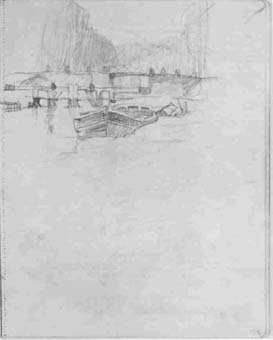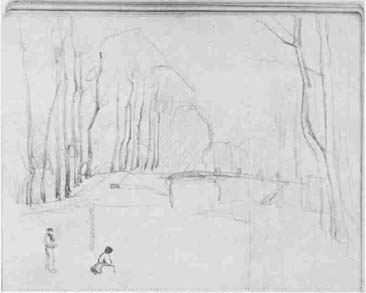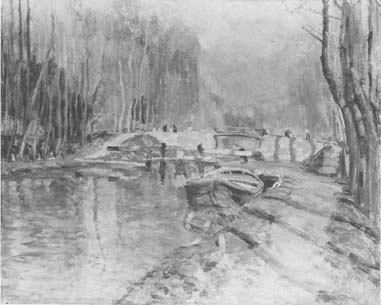
Annual Bulletin 2, 1978-1979
Home
Français
Introduction
History
Annual Index
Author &
Subject
Credits
Contact






A. Y.
Jackson in France, Belgium and Holland:
A 1909 Sketch book
by Rosemarie L. Tovell
Pages 1
| 2
| 3 | 4
| 5
On pages 35 recto and 35 verso
(figs 18 and 19) are two drawings of the Canal du Loing near Episy,
drawn during the fall months of 1909. They are studies for one of the major
1909 canvases, the Canal du Loing (fig. 20). (22) The subject of the
painting probably originated with the detail drawing of the barge on page
35 recto (fig. 18). From the relative abundance of foliage on the
trees, it is evident that this drawing was clone a week or so earlier than
the drawing on page 35 verso (fig. 19) where the
bare trees are similar to those in the oil. Jackson remembered having
painted the canvas out of doors, so the drawings were likely used as aids
for detail and composition in completing the painting. The two drawings
have no colour or tonal notations, which further supports this theory.
What is perhaps the most interesting
painting done in 1909, October Morning, Episy (fig. 21), is also
represented in the sketchbook. The painting, a studio work, marks a major
advance in the artist's oeuvre, heralding the famous Edge of
the Maple Wood of 1910, which brought A. Y. to the attention of Lawren
Harris and other future members of the Croup of Seven. Like Edge of
the Maple Wood, October Morning, Episy concentrates on the light
and shadows flickering across the foreground and tree trunks. Although
in October Morning, Episy the paint is not applied with the same
impasto, nor is the composition as startling, still the colour, tones
and subject matter are remarkably similar to the 1910 canvas.
October Morning, Episy probably
started with an oil sketch. The drawing on page 34 recto (fig. 22)
may also be a studio piece, used to work out the details of the composition
and subject matter. The similarity of details such as the tree branches,
indicates that the drawing was used to "push", the painting along.
The three-sided frame drawn around the pencil study is typical of drawings
made by A. Y. after the first impression had been rendered and he already
knew what the limits of the composition were to be.
It is possible that other drawings in the sketchbook served as
preliminary compositions for paintings. If so, we may never
know for, like the paintings of the Groote Kerk, Veere, they were probably
either destroyed by the artist or lost. The sketch book can only give us
an indication of what might have been.
The Sketchbook After 1909
Once back in Canada, Jackson used his sketchbook
sparingly. Jackson was back in Montreal by Christmas
1909, for a family reunion.
In June 1910 he visited his aunts, Miss Geneva Jackson and Mrs Isabella
in Berlin (now Kitchener), Ontario. He took along the sketchbook and
some of the 1909 paintings. When A. Y. arrived, his aunts were in
the middle of a major renovation of their home. As his contribution to
the effort, A. Y. painted a frieze on the walls of his Aunt Geneva's
bedroom. The subjects of the Kitchener decoration, now destroyed, were roof
tops, sheep, and the Antwerp Cathedral. He may have used some of the drawings in the sketchbook
as reference material, but most of the subjects seem to have
come from postcards such as the one depicting sheep that he had sent to
his mother from Europe and then asked her to send on to him in Kitchener. (23)
Two sheets in the sketchbook may suggest that the idea of the Kitchener
decoration was not a spur-of-the-moment whim on Jackson's part. The drawings
on these pages (31v and 38r; see fig. 23) are three-and-four-strip drawings
of seascapes and the Dutch coast. Their overall composition and style suggest
some sort of decorative purpose. But there is no clue as to their purpose
in Jackson's correspondence of the period, and all that can be said of these
two sheets of drawings is that they seem to be interesting prefigurations
of the Kitchener frieze.
During his stay at Kitchener, Jackson
met another branch of the family, the E. P. Clements, including his second
cousin Charles Bowlby Clement. The Clements invited Jackson to their summer
cottage at Portage Point on Georgian Bay, where Jackson stayed from late
June through July. During his first visit to Georgian Bay, in July 1909,
Jackson wrote: "It's a great country to have a holiday in...but it's nothing
but little islands covered with scrub and pine trees, and not quite paintable....Sketching simply won't
go." (24) When Jackson left the Clements'
cottage, the sketch book remained behind with the Clement family who farsightedly
kept it intact.
This sketchbook thus escaped the fate
of the others in Jackson's possession; they were broken up, and the drawings
were given away or sold. The one drawing known to be lost from this 1909
sketchbook may have been a gift to family or friends, or simply thrown
away. As this important sketchbook was safely in the care of Charles Bowlby
Clement and his descendants, it remains the only virtually complete sketch
book by A. Y. Jackson.
Next Page | Notes
1
| 2
| 3 | 4
| 5
Annual Index | Author & Subject | Credits | Contact
This digital collection
was produced under contract to Canada's Digital Collections program,
Industry Canada.
"Digital
Collections Program, Copyright
© National Gallery of
Canada 2001"